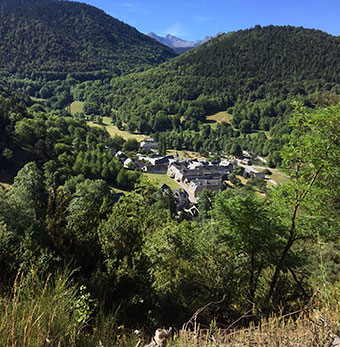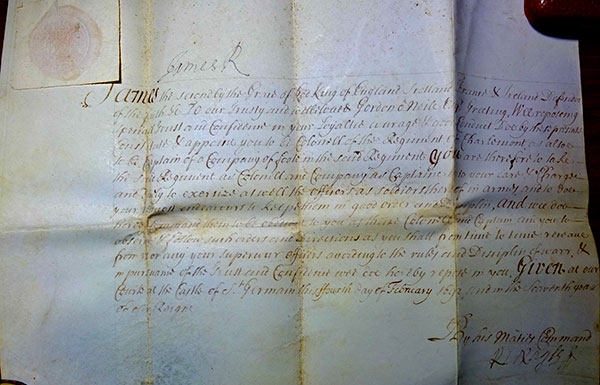The commissioning of Gordan O’Neill
Published in Features, Issue 5 (September/October 2021), Volume 29By Colum Kenny

Above: The village of Gouax in the French Pyrenees where Gordon O’Neill’s 1692 commissioning parchment was discovered.
In a small village in the Pyrenees they handed me a faded manuscript. The French owners of the house at Gouaux (as high as the top of Ireland’s highest mountain) had found it among papers in their library. Unfolding it gingerly, I saw first the signature of Richard Nagle, attorney-general of Ireland and secretary of war under King James II. It was dated 1692, at Saint-Germain-en-Laye, where James set up court near Paris after fleeing Britain and Ireland.
Nagle had signed ‘by his majesty’s command’, appointing Gordon O’Neill (‘o’Neile’) colonel in charge of James’s ‘Regiment of Charlemont’ in France. A descendant of Hugh, the ‘Great O’Neill’, Earl of Tyrone, Gordon O’Neill (c. 1652–1704?) was no mere foot-soldier. He had been lord lieutenant of Tyrone and represented that county in the Irish ‘patriot parliament’ convened by James at King’s Inns, Dublin, in 1689. He had a remarkable escape from death at the Battle of Aughrim (see image).
A contemporary of Gordon noted his military prowess in Latin verses published a few years ago in Analecta Hibernica (2013). Diarmuid MacMuiredhaigh wrote him a praise poem in Irish, and c. 1701 Gordon was described in Irish legal proceedings as ‘a person of known worth, honour and courage …’.
Gordon’s regiment of Irish emigrants was one of a dozen such that fought on the French side in the War of the Grand Alliance (1689–97). He was a veteran of the battles in Ireland between James and William of Orange and their respective European allies.
Gordon’s father, Phelim O’Neill of Kinard, had been captured and executed in 1653 after trying to contact his third wife, who was detained with the infant Gordon in Charlemont Fort in Ulster. The fort had been built in 1602 by Charles Blount, Lord Deputy Mountjoy, as a thorn in the side of Gordon’s rebellious ancestor Hugh O’Neill. Phelim had held it during the 1640s. After Phelim’s death, his wife thought it best to raise Gordon outside the Catholic Church, but he later reverted to it. He married a Protestant, Mildred Mossom, and they are thought to have had three sons and two daughters. Mildred died in 1686 at Derry, where the family lived (Seanchas Árdmacha 24 (2) (2013)).

James R[ex]
James the second by the Grace of God King of England Scotland France & Ireland Defender of the Faith &c To our Trusty and well-loved Gordon o’Neile Esqr. Greeting. Wee reposing speciall Trust and Confidence in your Loyaltie courage & good Conduct, Doe by these presents Constitute & appoint you to be Colonell of the Regiment of Charlemont as also to be Captain of a Company of foot in the said Regiment You are therefore to take the said regiment as Colonell and Company as Captaine into your care & Charge and duly to exercise as well the officers as soldiers thereof in arms, and to doe your utmost endeavours to keep them in good order and Disciplin, and wee doe hereby command them to be obedient to you as their Colonell and Captain and you to observe & follow such orders and Directions as you shall from time to time receive from us or any your superiour officers according to the rules and Disciplin of warr, & in pursuance of the Trust and Confidence we doe hereby repose in you. Given at our Court at the Castle of S.t Germain this ffourth day of February 1692, and in the Seaventh year of our Reigne.
By his Ma’ties Command
R[ichard] Nagle
Until 1688 Gordon was a colonel and captain of grenadiers in the regiment of William Stewart, Lord Mountjoy, but when William of Orange challenged James II at the behest of powerful English interests who found James too sympathetic to Roman Catholicism, Gordon O’Neill raised his own foot regiment in Ulster and fought for James. He stationed himself at Charlemont Fort. In April 1689 King James and the Comte d’Avaux, French ambassador to the Jacobite court in Ireland, stopped there. The countryside around was swept bare by hostile armies and it is said that everyone except the king ‘ate horse-corn and drank water or detestable beer’. Later in 1689 a Williamite force laid siege to ‘obstinate and unconquered’ Charlemont. The fort held out until May 1690. Then Sir Teague O’Regan and Gordon O’Neill led out 800 soldiers, who left with honour on agreed terms, ‘with drums beating and colours flying’. Gordon had fought for James at the siege of Derry (1689), where he was wounded in the thigh, and went on to fight at the Boyne (1690) and Aughrim (1691). His infantry regiment was known by his surname (a common Irish practice then).
At Aughrim, Gordon and his regiment fought fiercely and seized some of the enemy’s cannon. The battle was almost won, with General St Ruth crying out ‘Le jour est à nous, mes enfants’ (‘The day is ours, my boys’). A stray cannon-ball killed St Ruth, however, and this turned the tide in favour of the enemy. Brigadier Gordon was left for dead in the slaughter at Aughrim but, ‘being recognized on the following day by some Scotch officers [on the other side], connected with him through his mother (who was of the noble house of Gordon in Scotland), they had him kindly attended to until recovered of his wounds’ (D’Alton, King James’s Irish Army, II, 635). His mother, Jean, was the daughter of George Gordon, 1st Marquess of Huntly, who had been ‘the principal Catholic noble in Scotland and arguably the most powerful lord in the Scottish Highlands’ in the early 1600s (Oxford Dictionary of National Biography).
Regaining his liberty under the terms of the Treaty of Limerick, Gordon O’Neill might have stayed in Ireland. Instead, he joined about 12,000 of the army who left Ireland for France, where the French king had given orders to take care of them.
In January 1692, as seen in the manuscript found at Gouaux, James appointed Gordon ‘Colonel of the Regiment of Charlemont and also to be Captain of a Company of foot [infantry] in the said regiment’. O’Callaghan (Irish Brigades, 120) thinks that Gordon’s regiment was probably designated in France the ‘Régiment de Charlemont’ from its colonel having been governor of Charlemont Fort and having long defended that fort for James with honour. Gordon was the only O’Neill given command of a regiment in the reorganisation of James’s diminished army in France.
The Charlemont regiment fought until the Peace of Ryswick in 1697. In 1698 it was dissolved in a reformation of Irish regiments. Gordon was then stationed at St-Germain-en-Laye. De Beauffort’s Histoire généalogique (1876) states that he had wed a French Catholic. He may have subsequently tried to raise a regiment in the service of Spain. The date of Gordon’s death after 1700, and its circumstances, are uncertain. The story of Gordon O’Neill and his regiment has not yet been fully told. Our thanks to the Angevin family for permission to reproduce the Gouaux manuscript.
Colum Kenny is Professor Emeritus of Communications at Dublin City University.
FURTHER READING
P. Lenihan, ‘The “Irish Brigade” 1690–1715’, Eighteenth-Century Ireland 31 (2016).
E. Ó Tuathghaill, ‘The fort of Charlemont in Tír-Eoghan and some of its associations’, Ulster Journal of Archaeology 17 (1911).
















